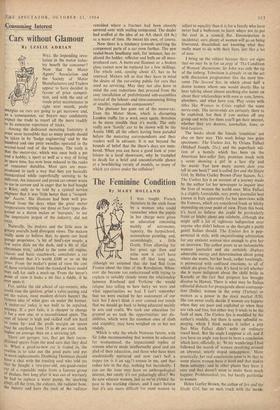Consuming Interest
• 'Cars without Glamour
By LESLIE ADRIAN
Among the dedicated motoring fraternity it must seem incredible that so many people should be taken in by 'badge engineering' and by the htmdred and one petty swindles operated in the second-hand end of the business. The truth is that the motor-car, which was once both a pet and a hobby, a sport as well as a way of living in spare time, has now been reduced to the ranks Of consumer durables. Most cars are mass- Produced in such a way that they are basically standardised while superficially seeming to be different. An innocent and proud car-owner wrote to me in sorrow and in anger that he had bought a Riley, only to be told by a cynical service engineer that it was 'little better than a "souped- Up" Austin.' His illusions had been well pre- served from the days when the great motor corporations turning out three or four types dis- guised as a dozen makes or 'marques,' to use the impressive jargon. of the , industry, did not exist.
Naturally, the makers and the little men in greasy overalls hold divergent views. The makers really seem to believe that, to quote our local garage proprietor, 'a bit of bird's-eye maple, a few extra dials on the dash, and a bit of that chromium trim,' added to the same old engine, chassis and basic coachwork, constitutes a car so clifferent that it's worth £100 or so on the Price. From the maker's point of view the cost of these variations from the standard basic model may call for such a mark-up. From the buyer's Point of view it looks a bit like a fiddle, if he ever spots it.
For, unlike the old school of car-owners, who Could time the ignition, grind a valve seating, and set the valves, most modern drivers haven't the faintest idea of what goes on under the bonnet. A motor-car' today is not built to be repaired, anyway. If a part fails, it is cheaper to change II for a new one, or a reconditioned spare. The cost of labour is high and skilled staff are hard to come by—and the profit margin on spares may be anything from 15 to 40 per cent, much higher on average than on a servicing job.
There are garages, too, that get their recon- ditioned spares from the used cars that they deal in. When a good-as-new car is traded in, the routine is to take out the good parts and put in worn replacements. Doubting Thomases should have a chat with the trusting soul who told me ihat he bought a two-year-old, one-good-owner ear of a reputable make from a famous group of dealers. Not long after it was out of warranty he had to replace a water pump, the sparking Plugs, all the tyres, the exhaust, the radiator hose, the battery and have the neck of the radiator
reweldecl where a fracture had been cleverly covered over with sealing compound. The dealer had scoffed at the idea of an AA check (£4 4s.) as a waste of time. He meant his own, of course.
Now there is a tendency towards unifying the component parts of a car even further. The new sealed-beam headlamp unit, for instance, has re- placed the holder, reflector and bulb on all mass- produced cars. A burnt-out filament or a broken glass cannot now be replaced for a few shillings. The whole unit, costing about £3, has to be renewed. Makers tell us that they have in mind the desire of the car-owing public for cars that need no servicing. May they not also have in mind the cost reductions that proceed from the easy installation of prefabricated sub-assemblies instead of the labour- and time-consuming fitting of smaller, replaceable components?
The glamour has gone out of the motor-car. Even the Motor Show, which is disrupting London traffic for a week once again, threatens to be more trouble than it's worth. The only really new 'family' car to be shown will be the Austin 1800, all the others having been paraded before the motoring correspondents and their readers well in advance. It is not beyond the bounds of belief that the Show's days are num- bered. When you can have a good look at your leisure in a local showroom, why be trampled to death for a brief and uncomfortable glance at a bewildering variety of models, so many of which are sisters under the cellulose?


































 Previous page
Previous page